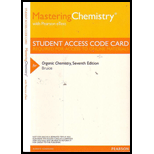
Concept explainers
(a)
Interpretation:
The major product obtained from addition of
Concept introduction:
Markovnikov’s Addition Rule: The unsymmetrical
(b)
Interpretation:
From the given compounds, the compound with high regioselective ability towards addition of
Concept introduction:
Markovnikov’s Addition Rule: The unsymmetrical alkene in a chemical compound reacts with hydrogen halide in a way, where halide ions attacks and bond to the more substitution position of carbon-carbon double bond.
(c)
Interpretation:
The major product obtained from addition of
Concept introduction:
Markovnikov’s Addition Rule: The unsymmetrical alkene in a chemical compound reacts with hydrogen halide in a way, where halide ions attacks and bond to the more substitution position of carbon-carbon double bond.
(d)
Interpretation:
The major product obtained from addition of
Concept introduction:
Markovnikov’s Addition Rule: The unsymmetrical alkene in a chemical compound reacts with hydrogen halide in a way, where halide ions attacks and bond to the more substitution position of carbon-carbon double bond.
(e)
Interpretation:
The major product obtained from addition of
Concept introduction:
Markovnikov’s Addition Rule: The unsymmetrical alkene in a chemical compound reacts with hydrogen halide in a way, where halide ions attacks and bond to the more substitution position of carbon-carbon double bond.
(f)
Interpretation:
The major product obtained from addition of
Concept introduction:
Markovnikov’s Addition Rule: The unsymmetrical alkene in a chemical compound reacts with hydrogen halide in a way, where halide ions attacks and bond to the more substitution position of carbon-carbon double bond.
Trending nowThis is a popular solution!

Chapter 6 Solutions
Organic Chemistry - Access
- Which of the following reactions result in a positive ∆ Ssys? A. Pb(NO3)2 (aq) +KCl (aq) ---> PbCl2 (s)+ KNO3 (aq) B. HCl (g) + H2O (l) ---> HCl (aq) C. H2 (g) + I2 (g) ---> 2HI (g) D. 2H2O (g) ---> 2H2 (g) + O2 (g) E. H2O (g) ---> H2O (l)arrow_forwardWhen methanitrobenzoic acid is reacted with bromomethane in the presence of Lewis acids, the product is: A. III No.B. V numbered structureC. Structure ID. Building IIE. Building IVarrow_forward16.G Predict the major organic productarrow_forward
- 1. The reaction of (Z)-3-Methyl-3-hexene with H2O/H2SO4 produces 3 – Methyl-3-hexanol (75 % yield) (a) Write a balanced chemical equation for the reaction [2 marks](b) Propose a mechanistic explanation for the reactionarrow_forwardIdentify the best reagents to console the following reactionarrow_forwardChoose the best reagents from the list provided below for carrying out the following conversion. Match the reagent with the step number. HCl (aq), Zn(Hg) Br2, FeBr3 Na/NH3, -33 degrees C NBS, light KMnO4, H3O+ Mg metal, ether KOH, EtOH, heatarrow_forward
- What is Lucas reagent? 2,4-Dinitrophenyl hydrazine ZnCl₂ in Conc. HCl Ammonical AgNO₃ A solution of sodium carbonate, sodium citrate and copper(II) sulphatearrow_forward9. Product of the reaction of nitrobenzene with sulfuric acid in the presence of oleum at 60 °C:a) o-nitro benzenesulfonic acidb) m-nitro benzenesulfonic acidc) p-nitro benzenesulfonic acidd) None of the above 10. Due to their ability to move through ducts or pipes, they are generally called fluids:a) Solidsb) Solid mixturesc) Gasesd) Liquids and gasesarrow_forward17.36 Tamoxifen is an estrogen receptor modulator that is used in the treatment of breast cancer. Provide the missing reagents and the structure of compound A in the synthesis of tamoxifen. Page 707 HO (CH3)2N 1. C,H,MgBr 2. H + Compound A (CH3)2N Tamoxifenarrow_forward
- Nicotinic acid, more commonly named niacin, is one of the B vitamins. Show how nicotinic acid can be converted to (a) ethyl nicotinate and then to (b) nicotinamide.arrow_forwardIdentify the reagents necessary for the reaction:arrow_forwardselect the most appropriate reagent(s) to effect the change. K2Cr2O7, H+ H2, Pd 1. Disiamylborane, 2. HO–, H2O, H2O2 NaOCl H2SO4, HgSO4arrow_forward
 Organic ChemistryChemistryISBN:9781305580350Author:William H. Brown, Brent L. Iverson, Eric Anslyn, Christopher S. FootePublisher:Cengage Learning
Organic ChemistryChemistryISBN:9781305580350Author:William H. Brown, Brent L. Iverson, Eric Anslyn, Christopher S. FootePublisher:Cengage Learning

